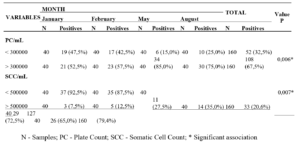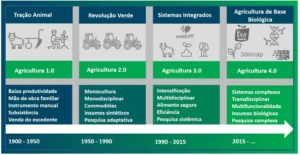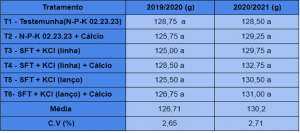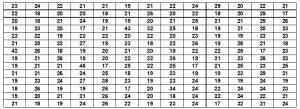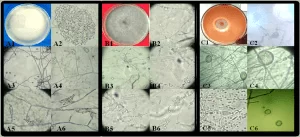ARTIGO ORIGINAL
ARAUJO, Valquíria Dayce da Silva [1], SANTOS, Danilo Marcelo Aires dos [2], BARBIERI, Rayner Sversut [3], RAMOS, Michele Ribeiro [4]
ARAUJO, Valquíria Dayce da Silva. et al. Current scenario of pastures in the state of Tocantins. Revista Científica Multidisciplinar Núcleo do Conhecimento. Year. 08, Ed. 03, Vol. 03, pp. 05-30. March 2023. ISSN: 2448-0959, Access link: https://www.nucleodoconhecimento.com.br/agronomy-en/pastures, DOI: 10.32749/nucleodoconhecimento.com.br/agronomy-en/pastures
ABSTRACT
The state of Tocantins is located in the new agricultural frontier of Brazil, a region that comprises Matopiba (a region comprised by the states of Maranhão, Tocantins, Piauí and Bahia). The state is characterized by cattle ranching, occupying 6.2 million hectares of planted pastures and with an effective cattle herd of 10 million head. Pastures occupy a prominent place in the beef production chain. In 2021, 79 million tons of meat and meat products were produced. The state has been seeking to adapt to sustainable production models, aiming at the intensification of these pastures, at the same time that agriculture has been expanding. There is a process of change in the use and occupation of these areas. Thus, this work aimed to describe the scenario of pastures in the state of Tocantins, to characterize the main changes and advances in the region and the economic prospects and future challenges. The research was developed in the format of a bibliographic review, and was based on selecting bibliographic sources through data collection, exploratory and selective reading, analysis and interpretation of the results found. For the present study, the dialectical method was used, based on arguing and counter-arguing with the ideas of different authors, integrating their ideas with the ideas of the researcher. The choice of this method, and because it is a bibliographic study, was made through the qualitative approach of exploratory character, at the time of interpretation. In this work, the exploratory study was adopted as a methodological strategy, through a bibliographic research, developed from material already elaborated, consisting of books and scientific articles. It is concluded that the pasture areas present stability in the state of Tocantins. There is a dynamic process in the use of these areas for agriculture and other purposes, with increased productivity in recent years, but it still faces challenges regarding the adoption of management practices.
Keywords: Agricultural frontier, Degradation, Cerrado, Livestock.
1. INTRODUCTION
The herd in the state of Tocantins is estimated at 10 million head, according to the State Agricultural Defense Agency (MARTINS; GOVERNMENT OF TOCANTINS, 2022). The pasture areas total 8.4 million hectares (IBGE, 2017). The MapBiomas Platform (2021) presents a quantity of 6.2 million ha (hectare) of pastures due to its methodology.
Agricultural production has gained prominence in recent years, however, historically, beef cattle breeding is one of the most important sectors for the state’s economy, since it has been showing promise in the face of commercial export transactions (MIURA, 2020). Beef is the second most exported product by the state. In 2021, the state occupied the eighth position in the national ranking of meat suppliers for export (ABIEC, 2021).
According to the Brazilian Association of Refrigerators – Abrafrigo[5] (2021), exports of beef and derivatives in 2020 in the state of Tocantins were 81.68 million t (tons), while in 2021, they were 79.01 million tons. These data demonstrate the importance of meat production for Tocantin agribusiness. The Tocantins herd increases every year, and is characterized mainly by pasture production systems (GOVERNO DO ESTADO DO TOCANTINS, 2021). The planted pasture areas are occupied with cultivated forages, according to MapBiomas (2021), and that serve as a basis for animal feed, so mapping these areas becomes an economic strategy.
The pastures in Tocantins have been going through a process of changes, with regard to the use and occupation of the land. The technology that underpins the surveys of georeferenced data in Landsat satellites, available on the MapBiomas platform, has allowed to better quantify the areas, and in addition to the size of the planted pasture areas, the quality of these pastures, regarding the levels of degradation in recent years, and the main changes that have occurred in land use.
Thus, this bibliographic review aims to describe an overview of the scenario of pastures in the state of Tocantins, in order to characterize the main advances in the production of planted pastures, as well as to present the economic prospects for Tocantins cattle ranching, an analysis through data surveys of regulated agencies.
2. MATERIAL AND METHODS
For the present study, the dialectical method was used, based on arguing and counter-arguing with the ideas of different authors, integrating their ideas with the ideas of the researcher, as presented by Mazzonetto et al. (2017).
The choice of this method, and because it is a bibliographic study, was made through the qualitative approach of exploratory character, at the time of interpretation.
In this work, the exploratory study was adopted as a methodological strategy, through a bibliographic research, which, according to Gil (2008), is developed from material already elaborated, consisting of books and scientific articles. Thus, the work had the following stages:
1) selection of bibliographic sources related to the theme proposed in this work. The search was conducted in academic websites, journals and libraries;
2) data collection from the selected sources considering the following premises:
- exploratory reading of all the selected material (quick reading that aims to verify if the work consulted is of interest to the work);
- selective reading (further reading of the parts that really matter);
- recording of information extracted from sources in a specific instrument (authors, year, method, results and conclusions).
3) the results were analyzed and interpreted in experiments carried out, data surveys.
4) based on the selected works, it was possible to discuss:
- the characteristics of Tocantins cattle ranching, in addition to describing the profile of the cattle rancher in relation to the agricultural production system in Tocantins, as well as the cultivation system used and the adoption of management practices such as the use of pesticides and fertilization.
- the scenario of pastures in Tocantins, as well as the predominant livestock production system and how the average stocking rate has presented itself in recent years.
- how the use of forage in pastures has contributed to the increase in animal production and which are the main forages used or cultivated in regions of the Cerrado.
- the dynamics and changes that occurred in the areas occupied with pastures and agriculture regarding land use and land cover in Tocantins.
- how agricultural production has expanded in Tocantins, with emphasis on the areas used with soybean cultivation, and the relevance of this commodity to the state’s economy.
- the percentage of degradation of pastures in Tocantins, and list the factors that cause and potentiate the increase in degradation levels in these pastures.
- how the recovery of pastures is configured as an economically viable alternative and report how Tocantins has structured its actions and measures in the search to reduce the Effects of Greenhouse Gases (GHG).
3. LITERATURE REVIEW
3.1 SCENARIO OF CATTLE RANCHING OF TOCANTINS
Tocantins has as one of the main economic activities the breeding of beef cattle. The state counted a cattle herd of 10 million head, pointing to an innovative scenario for the coming years, occupying a pasture area of approximately 8.4 million ha. However, in its classification, it brings a total of 6.2 million ha in pastures (IBGE, 2017; MAPBIOMAS 2021; MARTINS; GOVERNO DO ESTADO DO TOCANTINS, 2022).
It is important to analyze the available data about the pasture areas in Brazil and Tocantins in order not to generate misconception about the information and data available in accredited platforms or institutions. This paper presents quantitative available by institutions such as the Brazilian Institute of Geography and Statistics (IBGE)[6] and the MapBiomas Platform. However, caution is necessary so that comparisons do not occur, in order not to generate inaccurate or erroneous answers, since the purpose and methodology of both are characterized differently (PARENTE et al., 2020).
Thus, the discrepancies in values found between one institution and another can be justified by the fact that the classification methodologies, results, territorial scope and frequency of data collection differ in both. An example is the pasture areas, which the IBGE classifies as natural and planted, while MapBiomas classifies them into pasture, country or savanna formation and also mosaic of agriculture and pasture.
Among the municipalities that concentrate the largest cattle herds in the state are Arraias, Porto Nacional, Jalapão and Dianópolis, in the eastern mesoregion. In the western mesoregion are the municipalities of Gurupi, Formoso, Araguaína and Miracema do Tocantins (IBGE, 2020). Generally, cattle of the Gir breeds, for the beef and milk activity, and Nelore, for beef, are found. Together they represent 86.00% of the total herd (TOCANTINS GOVERNO DO ESTADO, 2021). The Gir breed is a Zebu breed, characterized by its dairy genetics and basis for crossing other breeds such as the Girolando (Dutch versus Gir). The Nelore breed has as main characteristics the rusticity, fertility, precocity and weight performance, used for meat production (MIRANDA; FREITAS, 2009).
According to information from Canal Rural (2022), total exports of beef and its derivatives in 2021 showed a 7.00% decrease in total volume and a 9.00% growth in revenue compared to the 2020 movement. However, the North region had a share of 17.00% of the national volume.
The Tocantins herd is characterized by being generally raised on pasture, so there is a need for more investments and technologies to optimize the use of pastures, that is, to invest in soil correction, fertilization and systems aimed at soil conservation. This would represent a use of up to 90.00% of the pastures (GOVERNO DO ESTADO DO TOCANTINS, 2021). According to the Department of Agriculture, Livestock and Aquaculture, in the state of Tocantins, 70.00% of the cattle herd and 75.00% of the pastures are along the North-South Railway.
In the state of Tocantins, the areas in which only planted pastures predominate, in the year 2000, totaled 5.5 million ha. In 2020, these areas accounted for 6.2 million ha, an increase of approximately 700,000 ha. The classification methodology of what is considered pasture, in the MapBiomas platform, are the areas that present predominantly planted pasture characteristics, linked to agricultural activity. Therefore, the areas of natural pasture are predominantly classified as a country formation that may or may not be grazed (MAPBIOMAS, 2021).
However, it is noteworthy that these pasture areas do not include the mosaic of agriculture and pasture, a classification of MapBiomas that includes areas of agricultural use that were not possible to be distinguished between pasture and agriculture, or even areas that are classified in the Class of Campestre Formation, being characterized by a predominance of herbaceous stratum (dirty field, campo limpo and campo rupestre (MAPBIOMAS, 2021).
The profile of the cattle rancher from Tocantins reflects on the current situation of pastures in the state. It is usually characterized by extensive production systems, non-replacement of nutrients, inadequate management of stocking rate and forage consumption (BORGHI et al., 2015). However, these factors are indicators of how the support capacity of pastures is characterized.
The carrying capacity comprises the maximum stocking rate, to obtain a certain level of animal performance, in grazing method, in a given time, without causing degradation in the ecosystem. The stocking rate is the ratio of the number of animals by the area of the occupied management unit, in order to standardize the effect of the animal on the pasture area (PEDREIRA, 2002).
The average stocking rate rates in Tocantins demonstrate a small advance, however, the support capacity of pastures presents deficiency in relation to management (GOVERNO DO ESTADO DO TOCANTINS, 2021). The extensive exploitation of pastures limits the carrying capacity, which does not exceed 0.5 Animal Units (AU) per ha, together with the low rates of forage production of the species used in grazing (BORGHI et al., 2015).
The support capacity and management of pastures are very variable depending on factors such as climate, soil, time of year and forage species or cultivar. The necessary or desired livestock productivity and the production system adopted also have a marked effect on the support capacity of the pasture, which is a premise for the determination of the animal stocking rate (ZIMMER et al., 2012).
The relationship between the number of animal units and the area occupied by these animals during a given period is called the stocking rate. This parameter assists in decision-making in the management and strategies in the establishment of the demand for food, aiming at the good use of pastures by the animals (AGUIAR; SANTOS; BALSALOBRE, 2006).
The Tocantins cattle herd has prospects of increasing every year, and the average stocking rate has shown an increase in recent years. In Tocantins, the soil and climate are favorable for cattle breeding, and the support capacity of pastures requires attention, since there is potential to achieve higher yield in animal unit per area.
Data presented by the Beef Intelligence Center – Cicarne (2019), a program of Embrapa Beef Cattle in partnership with the Laboratory of Image Processing and Geoprocessing (LAPIG)[7] and IBGE, demonstrated, through a historical series, the evolution in the average stocking rate of the state of Tocantins, as well as showed a growth over the years. In 1985, the average stocking rate was 0.654 animals ha-1, while in 2019, an average of 1.524 animals ha-1 was recorded (Figure 1).
Figure 1 – Average stocking rate in the state of Tocantins (1985 – 2019)
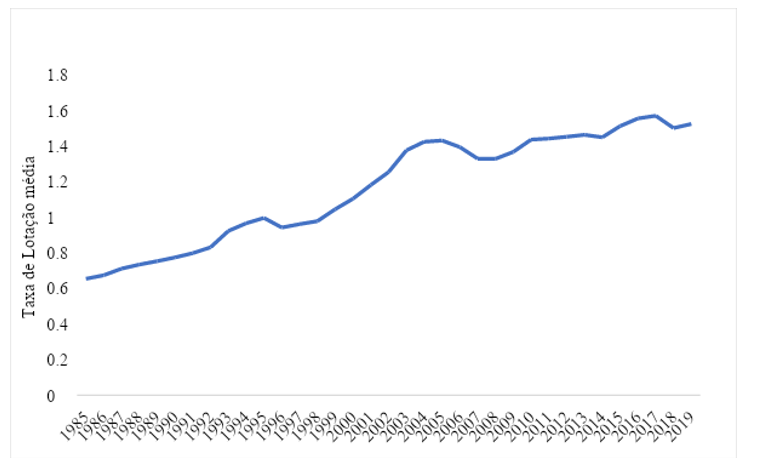
3.2 FORAGES ON PASTURES
As a result of the changes that have been happening in the livestock production model in the last three decades, as well as the evolution of the cattle herd and pasture areas in the country, there is an increase in the productivity of pastures. However, this trend has been particularly evident in regions where there is a growth in cattle herd, particularly in the North region (DIAS-FILHO, 2017).
It is possible to notice that the cattle ranching of the Cerrado has evolved to the predominant use of cultivated pastures. Currently, the producer has access to a wider range when choosing the appropriate forage depending on the type of environments and their recommendation for different production systems (MIURA, 2020).
Pasture management is related to actions, with regard to obtaining results without compromising forage plant development and soil quality (SANTOS, 2010). Therefore, grazing management is related to the manipulation of the animal in relation to grazing, with a view to or in pursuit of a defined objective (PEDREIRA, 2002).
For Silva and Nascimento Júnior (2007), in Brazil, pasture management, the introduction and evaluation of new grasses and legumes have long been a priority goal in tropical forage experimentation programs.
Genetic improvement in forages has been one of the main drivers of increased productivity, improvement in support capacity and nutritional value from the use of cultivated forages, which makes the improvement program so relevant for the agricultural sector (MIURA, 2020).
According to Fonseca and Martuscello (2022), there are different forages that can be used in the animal production system, each with specific agronomic characteristics, and having this knowledge about them is of great importance, because understanding the morphology and physiology of the forage to be used is what guides an appropriate choice and efficient management of a given forage.
It is important to know about the ideal conditions for the germination of a given species, environmental factors such as water, temperature and light (CARVALHO; NAKAGAWA, 2000).
The biological potential of each adapted forage species depends on the climate of the ecosystem in which it will be inserted, the temperature, the availability of water, the fertility of the soil and the amount of solar radiation necessary for its development, are important factors in determining the amount and nutritional value of forage (FONTANELI; SANTOS; FONTANELI, 2012).
Among the various species of forage grasses that are presented as options for the formation of fields in tropical savannas, in Brazil, the species of the genus Brachiaria (Trin.) Griseb. have had great importance, in the last 30 years, for the country’s economy, since it made possible the livestock activity in weak and acidic soils of the Cerrados. The Brachiaria decumbens , later replaced by Brachiaria brizantha , were pioneers in occupying large areas of the Cerrado (MACHADO, 2010).
According to Macedo (2013), among the most adapted genera in Cerrado regions, the most common are Brachiaria, Panicuns and Andropogon.
Among the latest cultivars developed in Embrapa’s improvement programs for grazing in the Cerrado region are BRS paiaguás, launched in (2013), BRS Zuri (2014), BRS Tamani (2015), BRS Kenya (2015) and BRS Ypiporã (2015) (MIURA, 2020), cultivars developed to meet production and sustainability niches within the agricultural system.
However, one of the causes of failure regarding the use of existing forages is the lack of information about the management of adequate grazing (FONSECA; MARTUSCELLO, 2022).
Another striking factor in the use of these forage species is that they have been used in an extractive way, without due concern for the replacement of soil nutrients and adequate management, and, with this, these exhaustively exploited grasses enter a process of withering, with a marked risk in the loss of productivity (COSTA, 2006; PAULA et al., 2017).
3.3 LAND USE AND COVER IN THE STATE OF TOCANTINS
In the mid-1970s, the Cerrado became the newest Brazilian agricultural frontier. The low value of the land, the access to credit lines, the introduction of forage species with the capacity to adapt to the soils of low fertility and the climate conditions of the Cerrado explain the great expansion in livestock production in this region (PERON; EVANGELISTA, 2004).
In the last forty years, the modernization of agriculture in the Cerrado has resulted in changes in land use and cover, marking the beginning of the process of converting the natural vegetation characteristic of the Cerrado to the production of the so-called agricultural commodities (MINISTÉRIO DO MEIO AMBIENTE, 2015).
The transformations and modifications, regarding the use and occupation of the land in the state of Tocantins, portray how the process of expansion of agribusiness in this territory took place, driven by the demand for land and policies based on and directed to the opening of new areas for agricultural activities, therefore, follow the same trend of the national scenario. Among the productive sectors, cattle ranching stands out in the occupation of the territory of Tocantins, from the opening of the areas that were occupied by forests and areas characterized as being Cerrado to the speculation of lands, moved by the movement of separation of the state of Goiás (VERGARA, 2021).
However, just as livestock agriculture has an important role with regard to changes in land use and cover, changes occur on a large scale, modifying and generating complex patterns in the territory in a long term (GOVERNO DO ESTADO DO TOCANTINS, 2012).
Data from the Mapping of Pastures in Brazil, between 1985 and 2020, demonstrate that there was a growth in the areas occupied by planted pastures until 2000. Subsequently, there was a period of stability in these areas, and then there was a decrease of 6.60% compared to what was identified in 2006 (Figure 2) (MAPBIOMAS, 2021).
Figure 2 – Pasture area in Brazil (1985 – 2020)
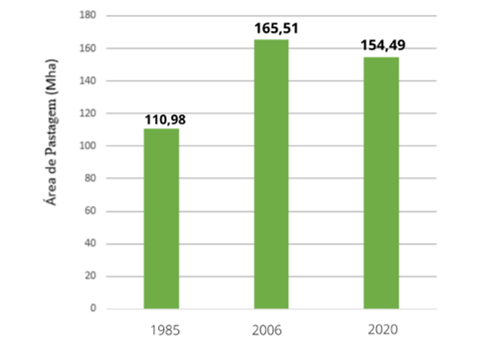
Tocantins is one of the states that make up the Cerrado Biome, which has been demonstrating a significant dynamic in the use and occupation of land in its territory. MapBiomas data on land use and land cover show that, in 2020, 52.76% of the territory was composed of forests, subdivided into forest formation and savanna formation, while 16.94% of non-forest natural formation (flooded field, marshy area and countryside formations). For agricultural use, 28.82% and 0.40% are classified as non-vegetated area and 1.08% occupied by water (Table 1).
Table 1 – Land use and cover in the state of Tocantins
| Land use and cover | Year 2020 (ha) | Percentage (%) |
| Forests (forest formation and savannah) | 14.635.667 | 52,76 |
| Non-forest natural formation (flooded field, marshy area and grassland formations) | 4.700.214 | 16,94 |
| Agricultural use | 7.996.05 | 28,82 |
| Non-vegetated area | 110.93 | 0,40 |
| Occupied by water | 299.42 | 1,08 |
| Total | 27.742.29 | 100,00 |
Source: Adapted from MapBiomas (2021).
The state of Tocantins has 27,742,298 thousand ha, of these, 7,996,056 ha are for agricultural use, divided between areas of pasture, agriculture, forestry and mosaic of agriculture and pasture (MAPBIOMAS, 2021).
The areas of pastures planted in Tocantins increased from 2,938,410 thousand ha in 1985 to 6,024,187 thousand ha in 2006. Subsequently, in 2020, it totaled an area of 6,113,329 thousand ha, presenting a stability in the last fourteen years (MAPBIOMAS, 2021).
Table 2 shows the accelerated growth of agriculture in Tocantins, from 10,368.00 ha in 1985 to 1,123,846.00 ha, usually in areas occupied with temporary crops, mainly soybeans. Forestry areas show significant growth, which points to a redirection of land use for this purpose. However, the areas classified as mosaic of agriculture and pasture, that is, areas that are not distinguished between one class or another, demonstrate that there was a decrease from 1,254,615.00 ha in 1985 to 756,802.00 ha in 2020.
Table 2 – Land use and cover for agricultural use class in the state of Tocantins
| Land/agricultural use and cover | Year 1985 (ha) | Year 2006 (ha) | Year 2020 (ha) |
| Pastures | 2.938.410,00 | 6.024.187,00 | 6.113.329,00 |
| Agriculture | 10.368,00 | 255.415 | 1.123.846,00 |
| Silviculture | – | 681,00 | 2.079,00 |
| Mosaic agriculture/pasture | 1.254.615,00 | 402.120,00 | 756.802,00 |
| Total | 4.203.394,00 | 6.682.404,00 | 7.996.056,00 |
Source: Adapted from MapBiomas (2021).
Surveys on land use and land cover and how its occupation dynamics are configured are an important tool to assess the capacity for environmental support, which actually contributes to a better identification of viable alternatives that promote sustainable development (GOVERNO DO ESTADO DO TOCANTINS, 2012).
When analyzing the current production systems in the state of Tocantins, it is verified, in general, that they follow a sequence: extraction, stage of production, consumption, disposal or abandonment, a model of production chain that, from the environmental point of view, is unsustainable (FRAGOSO; CARDOSO, 2022). The areas of pastures planted in Tocantins showed a rapid growth from 1985 to 2000. In the following years, until 2020, they showed stability in these areas.
3.4 CULTIVATION SYSTEMS AND MANAGEMENT PRACTICES IN TOCANTINS
The 2017 Agricultural Census, conducted by the IBGE, brought data on the number of establishments in the State of Tocantins and how agricultural production is configured within them, in relation to the cultivation techniques used, the use of pesticides and the realization of fertilization. The results show that, regarding soil preparation, 68.00% of the establishments perform the minimum cultivation, 25.00%, conventional cultivation, and 7.00%, no-tillage in straw. Regarding the use of pesticides, 74.00% of the establishments did not use them, 23.00% used pesticides and 3.00% of this total stated that they use them, but do not need to. Regarding the use of fertilization in Tocantin establishments, 80.00% did not perform fertilization, 14.00% performed chemical fertilization, 4.00%, organic fertilization, and 3.00% made use of chemical and organic fertilization (IBGE, 2017).
Some growers still face difficulties in adapting their cultivation system to the no-till system on their properties. In Tocantins, what has predominated is the minimum cultivation system of soil rotation (BORGHI et al., 2015). The no-till system and integrated production systems are not yet a reality for all producers. These are systems recommended to those who have machinery, skilled labor, knowledge and initial investment capacity.
3.5 EXPANSION OF PASTURE AREAS FOR AGRICULTURAL PRODUCTION IN TOCANTINS
Agriculture has advanced in Tocantins with the production of grains, and the areas expanded for this purpose have been, mainly degraded pasture areas (BORGHI et al., 2015). Migration to agricultural crops has occurred throughout the country, mainly in the form of leasing, in order to recover unproductive areas.
Since its creation, Tocantins is one of the Brazilian states with the greatest tradition in beef cattle, and has significantly developed the production of grains, mainly soybeans, which has led soybeans and beef to represent 95.00% of the products exported by the state. The cultivation of soybeans has gained relevance and is occupying large proportions of pasture areas in all regions of Tocantins. Many cattle ranchers are adhering to this production system, occupying part of their areas for renewal of their pastures. In the 2020/21 harvest, Brazil had an area planted with soybeans of 38,530 thousand ha and reached a production of 135,916 million tons, thus having a productivity of 3,527 kg ha-1 (BORGHI et al., 2017; FEITOSA, 2019; CONAB, 2021).
Such growth in soybean cultivation for recovery of unproductive areas or income diversification resulted in financial increases in the gross value of production in the country. According to the Department of Finance and Planning of Tocantins, in 2020, between January and September, the state of Tocantins reached a surplus of US$ 1,031.8 million in exports. The main products exported, according to the Ministry of Industry Foreign Trade and Services, were soybeans, US$ 812 million, with a 73.00% share, followed by beef, with US$ 231 million and a share of 18.00%, and other products, US$ 99 million, with a share of 9.00% in the total share (TOCANTINS GOVERNO DO ESTADO, 2020).
Data from the 12th survey of the National Supply Company – Conab (2021), the state of Tocantins obtained a productivity of 3,526 kg ha-1 in the 2020/21 harvest, in a planted area of 1,119 thousand ha, thus demonstrating an increase in planted area in relation to the cycle of the last 5 years (2016/17), when the total area occupied with soybeans was 964 thousand ha (Figure 3).
Figure 3 – Area planted with soybeans in the state of Tocantins (2016 – 2020)
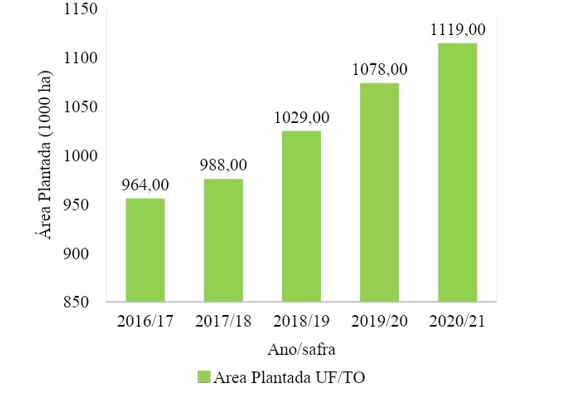
The development of the soybean agribusiness in Tocantins was the result of the actions and public policies of the state, which offered conditions and promoted all the necessary infrastructure for its expansion, even with the commitment of natural resources and the impacts on the territories of traditional communities. The expansion of planting areas, the growth of production and the increase in soybean productivity has been generating a financial surplus to the state (DIAS et al., 2016).
3.6 DEGRADATION OF PASTURE AREAS IN THE STATE OF TOCANTINS
Grassland degradation is a sharp and persistent decline in pasture productivity over time, causing major economic and environmental damage. Understanding this process and knowing how to avoid and reverse the problem is fundamental to increase the productivity of the field and reduce deforested areas (DIAS-FILHO, 2017).
Reducing support capacity, without necessary pasture management measures, reduces the quantity and quality of available forage. Under these conditions, the area will begin to show unevenness, with areas without forage and exposed soil. Next, there is the possibility of weed and pest infestation, due to the reduction of the competitiveness of pastures, which cannot be recovered naturally (PEIXOTO, 2021).
The realistic way to assess whether pasture is deteriorating is to track management for the carrying capacity of that pasture over time. In general, the support capacity is the number of animals that can be raised in a given pasture area without affecting the animal performance and the perenniality of the pasture (DIAS-FILHO, 2017).
Among the factors that lead to the degradation of pastures, the incorrect choice of forage species to be used, the initial malformation in the establishment, can be mentioned, non-maintenance fertilization and inadequate pasture management. That is, failure in any of these factors can accelerate the process of degradation of pastures (PERON; EVANGELISTA, 2004).
The effect of the grazing animal on the forage plant is defined by the intensity of grazing, the frequency, as well as the grazing cycle and the time of year, as well as the intensity of defoliation and the amount of forage removed by cutting or grazing depends on the climate and soil conditions, which is related to the regrowth capacity of the plant in a given grazing cycle (MARTHA JUNIOR et al., 2003).
The process of degradation of pastures is an obstacle regarding sustainable cattle ranching in the Brazilian Cerrado. The lack of importance given to soil fertility is among the factors that explain the degradation of pastures (MARTHA JUNIOR; VILELA, 2002).
According to Macedo (2005), the excessive stocking rate, the absence of fertilization in the system and the inadequate adjustment in the support capacity of these pastures are factors that have, in a way, further accelerated the degradation process in Cerrado regions.
According to Grise, Barbosa and Alcantara (2019), the state of Tocantins has about 5.5 million ha of pastures in situation or under some degree of degradation.
The degradation of pastures in the Cerrado ecosystem is a phenomenon that compromises sustainability in the animal production process. Among the main factors related to the degradation levels of these pastures in these regions is inadequate animal management and lack of nutrient replacement in the system (MACEDO, 2005).
Dias-Filho (2017) classifies degradation levels into four types, namely: mild degradation (level 1), moderate degradation (level 2), strong degradation (level 3) and very strong degradation (level 4), as described in Table 3.
Table 3 – Characterization of pasture degradation levels
| LEVELS OF DEGRADATION OF PASTURES |
| Level 1 – light: pasture still productive, but already with some areas of uncovered soils or weeds. The regrowth of the grass after grazing is slow. Support capacity drops about 20.00% (relative to undegraded pasture). |
| Level 2 – moderate: increase in weed infestation or percentage of uncovered soil (relative to level 1). Support capacity drops between 30.00% and 50.00%. |
| Level 3 – strong: excessive increase in weed infestation (agricultural degradation) or in the percentage of uncovered soil (relative to level 2). Very low proportion of forages. Support capacity drops between 60.00% and 80.00%. |
| Level 4 – very strong: predominance of uncovered soil with evident signs of erosion (biological degradation). Very low or non-existent proportion of forages. Support capacity drops above 80.00%. |
Source: Dias-Filho (2017).
In the MapBiomas (2021) results, degradation levels are classified by means of spectral fractions as NDVI – Normalized Difference Vegetation Index, surface reflectance value of Landsat satellite images. The resulting indices of these fractions is what indicates the quality of the pastures, which varies between 0 and 1, being 0 the productive pastures and 1 the very productive pastures. The variations between 0 and 1 are stratified into 3 classes, so the closer the index gets to 0, the higher the level of degradation (severe degradation). Average indices, between 0 and 1, indicate moderate degradation level, and indices close to 1 indicate levels of pasture without degradation (LAPIG, 2020).
Table 4 highlights differences in the quality of pastures in the state of Tocantins in the years 2000 and 2020, highlighting a positive evolution in the level of degradation.
Table 4 – Quality of pastures in the state of Tocantins/ Mapbiomas
| Quality of pastures | Year 2000 (mil.ha–¹) | Percentage (%) | Year 2020 (mil.ha–¹) | Percentage (%) |
| Severe degradation | 2.086.635 | 38,00 | 812.427 | 13,00 |
| Moderate degradation | 2.044.752 | 37,00 | 2.418.424 | 39,00 |
| No degradation | 1.412.844 | 25,00 | 3.050.282 | 49,00 |
| Total | 5.544.233 | 100,00 | 6.281.134 | 100,00 |
Source: Adapted from MapBiomas (2021).
The quality of pastures in Tocantins, according to the MapBiomas survey, is illustrated in the maps in Figure 4 (A, B), classified into three classes: severe degradation, moderate degradation and no degradation, forming a mosaic on the map of Tocantins as a result of the processes and changes that have occurred in these areas, regarding their quality, in the last 36 years.
Figure 4 – Map demonstrating the quality of pastures in the state of Tocantins: (A) quality of pastures in the state of Tocantins in the year 2000; (B) quality of pastures in the state of Tocantins in the year 2020
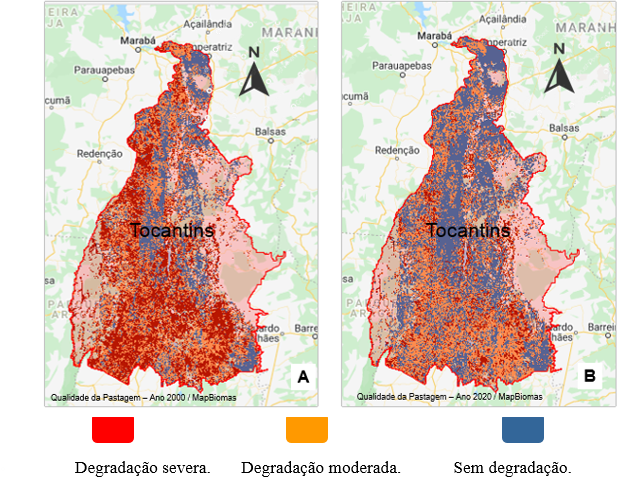
3.7 PASTURE RECOVERY: ECONOMIC DEVELOPMENT TOOL
In recent years, the pressure for sustainability within animal production systems has grown, that is, due to environmental issues and market requirements. In addition, there is an increase in the availability of technology for the sector, in relation to the formation, management and recovery of pastures, which has contributed to a change in posture in animal production in pastures in the country (DIAS-FILHO, 2014).
Sustainability, in a pasture production system, must be economically viable, socially fair and environmentally safe, that is, the only way to maintain the long-term perenniality of pasture is the sustainable system. Thus, the challenge becomes to recover those unproductive and unviable systems.
The country has a high rate of degraded pastures. If, on the one hand, it is a point of concern, on the other hand, it is a positive point, that is, recovering these degraded areas would avoid the opening of new areas and generate potential for increased productivity and profitability of national livestock. The recovery of productive potential in pasture areas is an alternative to minimize the opening of new agricultural frontiers to the detriment of regions with native vegetation. In recovered areas, there are higher yields and, consequently, greater sequestration of carbon dioxide (CO2) and conservation of the same in the soil (ANDRADE, 2015; DIAS-FILHO, 2014).
Tocantins has a total area of pastures estimated at 7.3 million ha, and about 5 million ha of pastures are under some degree or level of degradation. Among the states that make up the region of Matopiba, in the state of Tocantins, it is evident the fact that it has many areas of pasture in a situation of full degradation, which enables the state to recover these areas through the implementation of integrated production systems, without the need to deforest. This fact has been seen in recent years, in which pasture areas have been converted into areas used for grain production, mainly for soybean cultivation, in the 20/21 harvest, when it reached 1 million ha of planted area (CONAB, 2021; FRAGOSO; CARDOSO, 2022).
Integrated production systems are broad and varied. Many studies have been conducted in order to better elucidate which practices or cultures adapt in each region. It is up to local actors, producers and government agencies to access and apply such technologies in the field.
Even with the agricultural expansion in Tocantins and significant gains in productivity, the state still has much to advance in order to intensify production. In view of this, some of the options are in the implementation of integrated production systems, such as the Livestock Crop Integration System (ILP)[8] and the Livestock and Forest Crop Integration System (ILPF)[9], which are still very incipient in the state (FRAGOSO; CARDOSO, 2022).
Thus, the integration systems (ILPs), as well as the No-Till System (SPD)[10], are presented as viable tools and options in cases where crops and pastures are implemented intermediately in the renewal or recovery of pastures (MACEDO, 2013).
Tocantins, with Embrapa Fisheries and Aquaculture and state partnerships, has been working on the Plan for Mitigation and Adaptation to Climate Change, aiming to consolidate, in the state, an economy based on low carbon emissions (ABC Plan – TO), a project that aims to promote technological actions in order to reduce the emission of Greenhouse Gases (GHG) in agriculture (TOCANTINS, 2013).
Among the folders of the ABC+ Project – TO is the recovery of degraded pastures, which is part of program 1 of the Plano ABC Nacional (BRASIL, 2021).
The ABC+ Plan aims to organize and plan the actions to be employed for the adoption of sustainable production technologies, selected with the objective of meeting national commitments to reduce Greenhouse Gas (GHG) emissions in the agricultural sector. The ABC Project has been showing extensive development in the Cerrado. In total, it has already accounted for 93,000 ha of pastures that were in a situation of degradation and were recovered. The state of Tocantins recovered 20,129 thousand ha of degraded pastures in works carried out in forty municipalities, serving 446 properties distributed in the territory of Tocantins (SENAR, 2019).
In addition to the ABC+ Plan, there are numerous other public and private initiatives that assist rural producers in the area of recovery of degraded pastures, such as: Livestock + Brazil, Sustainable Livestock, Integra Zebu, Livestock + Healthy Milk, Payment for Environmental Services and ATeG SENAR Programa Restaurar / SEBRAE.
The recovery of a pasture is related to the reestablishment of the productive potential of forage, keeping the same species or cultivar in the area. According to Grise, Barbosa and Alcantara (2019), recovering pastures in a situation of degradation is a technological alternative to increase animal productivity, that is, to increase the number of arrobas per ha in a sustainable way, intensify production and thus minimize GHG emissions, cooperating to mitigate the effects of climate change. The renewal of the pasture consists of its reestablishment, with the replacement of the species or cultivar in relation to which it is degraded. Thus, the term pasture reform is characterized by repairs and corrections after the establishment of pasture (ZIMMER et al., 2012).
Tocantins presents climate conditions with favorable rainfall regime for agricultural production, with well-defined seasons and arable land. However, it is noteworthy that the pastures of Tocantins do not receive the deserved importance by producers, which raises the challenge when it comes to technicing or even intensifying these pastures. This fact coincides with results pointed out by the IBGE (2017), which show that 74.00% of the producers of rural establishments in Tocantins do not use agricultural pesticides and that (80.00%) do not use fertilization in their production system, that is, many producers still demonstrate resistance to the adoption of management practices. It is noted that the pastures in Tocantins present significant results, but are still conducted and exploited extensively (BORGHI et al., 2015).
In contrast, it is possible to observe that there was an improvement in the productivity of these pastures, since the pasture areas did not show a significant increase and the Tocantins herd continues to increase its quantity year after year. Among factors that explain this is the introduction of cultivars developed for soil and climate regions of the Cerrado, such as cultivars of the genus Brachiaria and Panicum.
It should also be noted that the predominant cultivation system in Tocantins is the minimum cultivation (BORGHI et al., 2015), with 68.00% predominance, followed by the conventional cultivation system, with 25.00%, and the no-tillage cultivation system, with 7.00% (IBGE, 2017), which, in a way, represents an advance in terms of soil conservation, since in the minimum cultivation system there is less soil turnover and less transit of machines in the area, which, in fact, reduces the likelihood of erosive processes that result in degradation.
Considering the areas that predominate only planted pastures, in 1985, Tocantins had an area of 2,938,410 thousand ha, to 6,113,329 thousand ha in 2020 (Table 2), an increase of 3,174,919 thousand ha in the last 35 years (MAPBIOMAS, 2021). It is verified that, from 2006 to 2020, there is a stability in the pasture areas in the state, an increase of 89,142 thousand ha. However, it is interesting to say that, considering also the areas of pastures that have been converted into temporary crops or classified in another class of use, it is possible to visualize a dynamic of expansion, retraction and stability in the pasture areas.
Noting that the stocking rate in Tocantins is 1.5 heads per ha, it is verified that this capacity is above the national average, which is 1.3 head per ha. Considering this index, it is possible to evaluate only the areas occupied with planted or grazed pastures, 6,113,329 thousand ha, and the amount of Tocantin herd, 9,129,804 thousand ha, (IBGE, 2020). It is noteworthy that there has been an increase in production in gain and efficiency per area, that is, Tocantins has been presenting a change in the pattern in the way of producing.
It is noted that, of the areas of agricultural use, the areas occupied by pastures are the ones that represent the largest quantity in Tocantins (Table 2). However, it is noticed that the use and land cover have been showing changes in the last 5 years, such as the increase of other classes of use, such as the areas occupied with forestry and agriculture (Table 2). It is noticed that, in recent years, the areas occupied with soybeans have grown rapidly. There are more than 1 million ha of planted area (Figure 3). The pressure and environmental requirements cause this growth to be contained, in order to avoid opening new areas, and, with this, many producers are using areas of pastures in a situation of degradation that, for some reason, were in idle condition or underutilized within the property, especially for soybean production (BORGHI et al., 2015).
On the other hand, not all rural producers can migrate the use and occupation of the land to agricultural activities. Crop rotation or integrated production systems must respect some basic prerequisites: availability of skilled labor, specialized technical assistance, specific agricultural machinery and implements, appropriate soil type, desirable topographical, and market outlet.
It is possible to observe that the form of extensive exploitation of pasture management culminated, in the year 2000, in large areas of pastures in a situation of severe degradation (Table 4). However, it is perceived that the quality of pastures in Tocantins has greatly improved, with regard to the levels of degradation described between 2000 and 2020.
The areas with signs of severe degradation (38.00%) and moderate degradation (39.00%) totaled almost 70.00% of the total area, and only 25.00% of these areas were not in a situation of degradation in the year 2000. However, it is possible to observe that the quality of pastures has been improving in recent decades, since, in 2020, the percentage of pastures in severe degradation was 13.00%, followed by 3.009% of moderate degradation and 49.00% without evidence of degradation, an increase of 24.00% compared to what was accounted for in 2000 (Figure 8).
Pasture recovery programs, aligned with the introduction of integrated crop systems, have been crucial tools for the improvement and sustainable development of agriculture in Tocantins.
4. FINAL CONSIDERATIONS
The pasture areas present stability in the state of Tocantins. However, there has been a dynamic process in the use of these areas for agriculture and other purposes.
The cultivars adapted to the Cerrado region, most found in Tocantins, are those of the genus Brachiaria, Panicum and Andropogon.
The results show that the pasture areas are more productive, the average stocking rate has improved, with gains per area, and also the quality of the pastures has been improving, although there are many areas in a situation of alert regarding the levels of degradation.
At the same time, it is seen that the way to manage the pastures within the properties is an obstacle regarding their intensification for a sustainable livestock, since the producer, in general, still does not have the culture to perform fertilization management and agricultural pesticides.
Agriculture has expanded in the state, especially with the opening of areas for the cultivation of grains (soybeans), as well as the implementation of areas occupied with forestry and or integrated system, through the development programs of low-carbon agriculture, a fact that has been creating new molds in the way of producing in Tocantins, in both agriculture and livestock in order to mitigate/reduce the effects of greenhouse gases.
REFERENCES
ABIEC – ASSOCIAÇÃO BRASILEIRA DAS INDÚSTRIAS EXPORTADORAS DE CARNE. Exportações: série histórica das exportações de carne bovina. Abiec, 2021. Disponível em: http://abiec.com.br/exportacoes/. Acesso em: 16 jun. 2022.
ABRAFRIGO – ASSOCIAÇÃO BRASILEIRA DE FRIGORÍFICOS. Exportação brasileira de carne bovina e derivados. Abrafrigo, 2021. Disponível em: https://www.abrafrigo.com.br/wp-content/uploads/2021/12/ABRAFRIGO-Exporta%C3%A7%C3%A3o-Carne-Bovina-Jan_2020-a-Dez_2021.pdf. Acesso em: 16 jun. 2022.
AGUIAR, André De-Stefani.; SANTOS, Patrícia Menezes; BALSALOBRE, Marco Antonio Alvares. Métodos de cálculo de taxa lotação em pastagens com suplementação. In: 43ª Reunião Anual da Sociedade Brasileira de Zootecnia, 2006. Disponível em: https://www.embrapa.br/busca-de-publicacoes/-/publicacao/47626/metodos-de-calculo-de-taxa-lotacao-em-pastagens-com-suplementacao. Acesso em: 20 jun. 2022.
ANDRADE, Carlos Augusto Oliveira de. Sobressemeadura de espécies forrageiras em soja para viabilidade do plantio direto e integração lavoura-pecuária no Tocantins. 2015. 66 f. Dissertação (Mestrado em Produção Vegetal) – Universidade Federal do Tocantins, Gurupi, TO, 2015.
MARTINS, Dinalva; GOVERNO DO TOCANTINS. Tocantins supera 10-milhoes de bovinos e alcança índice de 9896 de vacinação contra aftosa nos animais em idade vacinal. Tocantins Governo do Estado, 2022. Disponível em: https://www.to.gov.br/noticias/tocantins-supera-10-milhoes-de-bovinos-e-alcanca-indice-de-9896-de-vacinacao-contra-aftosa-nos-animais-em-idade-vacinal/29p4o1sidm0j. Acesso em: 23 out. 2022.
BORGHI, Emerson et al. Estado da arte da agricultura e pecuária do estado do Tocantins. Palmas: Embrapa Pesca e Aquicultura, 2015.
BORGHI, Emerson et al. Sobressemeadura de capins na soja para sistemas de Integração Lavoura-Pecuária. Palmas: Empresa Brasileira de Pesca e Aquicultura, 2017.
BRASIL. Ministério da Agricultura, Pecuária e Abastecimento. Plano setorial para adaptação à mudança do clima e baixa emissão de carbono na agropecuária 2020-2030: plano operacional. Brasília: Mapa/DEPROS, 2021.
CANAL RURAL. Carne bovina: exportações do Brasil fecham 2021 com queda de 7% em volume e alta de 9% em receita. Canal Rural, 2022. Disponível em: https://www.canalrural.com.br/noticias/pecuaria/carne-bovina-exportacoes-brasil/. Acesso em: 12 fev. 2023.
CARVALHO, Nelson Moreira; NAKAGAWA, João. Sementes: ciência, tecnologia e produção. 4ª ed. Jaboticabal: Funep, 2000.
CICARNE – CENTRO DE INTELIGÊNCIA DA CARNE BOVINA. Pecuária em números. Cicarne, 2019. Disponível em: https://www.cicarne.com.br/pecuaria-em-numeros/. Acesso em: 16 jun. 2022.
CONAB – COMPANHIA NACIONAL DE ABASTECIMENTO. Safra brasileira de grãos. Conab, 2021. Disponível em: https://www.conab.gov.br/info-agro/safras/graos/boletim-da-safra-de-graos. Acesso em: 17 fev. 2023.
COSTA, Kátia Aparecida Pinho. Adubação nitrogenada para pastagens do gênero Brachiaria em solos do Cerrado. Santo Antônio de Goiás: Embrapa Arroz e Feijão, 2006.
DIAS, Dayane Ramos. et al. A expansão do agronegócio da soja no Tocantins: contextualização dos impactos e mudanças no desenvolvimento regional. In: VII Jornada de Iniciação Científica e Extensão, 2016.
DIAS-FILHO, Moacyr. Bernardino. Degradação de pastagens: o que é e como evitar? Brasília, DF: Embrapa, 2017. Disponível em: https://www.infoteca.cnptia.embrapa.br/infoteca/bitstream/doc/1070416/1/TC1117CartilhaPastagemV04.pdf. Acesso em: 24 jun. 2022.
FEITOSA, Cid Olival. Panorama das atividades agropecuárias de exportação do Tocantins: soja e carne. Revista Geosul, v. 34, n. 71, p. 154-174, 2019.
FONSECA, Dilermando Miranda.; MARTUSCELLO, Janaina Azevedo. Plantas forrageiras. 2ª ed. Viçosa: Editora UFV. 2022.
FONTANELI, Renato Serena; SANTOS, Henrique Pereira.; FONTANELI, Roberto Serena (ee.). Forrageiras para integração lavoura-pecuária-floresta na região sul-brasileira. 2ª ed. Brasília: Embrapa, 2012.
FRAGOSO, Daniel de Brito; CARDOSO, Expedito Alves. Expansão da Agricultura no Estado Tocantins. In: COLLICCHIO, Erich; ROCHA, Humberto Ribeiro da (org.). Agricultura e mudanças do clima no estado do Tocantins: vulnerabilidades, projeções e desenvolvimento. Palmas, TO: EdUFT, 2022. Disponível em: https://www.infoteca.cnptia.embrapa.br/infoteca/bitstream/doc/1142986/1/Cap2.pdf. Acesso em: 08 jan. 2023.
GIL, Antônio Carlos. Como elaborar projetos de pesquisa. 4ª ed. São Paulo: Atlas. 2008.
GRISE, Marcia Mascarenhas; BARBOSA, Cláudio França; ALCANTARA, Pedro Henrique Rezende de. TT ILPF – construindo capacidades e inovando no setor produtivo do Tocantins e Sul do Pará. In: Congresso Técnico Científico da Engenharia e da Agronomia – CONTECC, Palmas, TO, 2019. Disponível em: https://www.alice.cnptia.embrapa.br/alice/bitstream/doc/1118257/1/CNPASA2019contecc.pdf. Acesso em: 20 jun. 2022.
IBGE – INSTITUTO BRASILEIRO DE GEOGRAFIA E ESTATÍSTICA. Utilização das terras. Censo agro 2017, 2017. Disponível em: https://censoagro2017.ibge.gov.br/templates/censo_agro/resultadosagro/estabelecimentos.html?localidade=17. Acesso em: 16 jun. 2022.
IBGE (2019)
IBGE – INSTITUTO BRASILEIRO DE GEOGRAFIA E ESTATÍSTICA. PPM – Pesquisa de pecuária municipal. IBGE, 2020. Disponível em: https://www.ibge.gov.br/estatisticas/economicas/agricultura-e-pecuaria/9107-producao-da-pecuaria-municipal.html?edicao=29151&t=destaques. Acesso em: 16 jun. 2022.
LAPIG – LABORATÓRIO DE PROCESSAMENTO DE IMAGEM E GEOPROCESSAMENTO. Atlas digital das pastagens brasileiras. Lapig, 2020. Disponível em: https://lapig.iesa.ufg.br/p/38972-atlas-das-pastagens. Acesso em: 16 jun. 2022
MACHADO, Luís Armando Zago et al. Principais espécies forrageiras utilizadas em pastagens para gado de corte. In: PIRES, A. V. (ed.). Bovinocultura de corte. Piracicaba: FEALQ, 2010. Disponível em: https://www.alice.cnptia.embrapa.br/alice/handle/doc/862836. Acesso em: 27 maio 2022.
MACEDO, Manuel Claudio Mota. Pastagens no ecossistema cerrados: evolução das pesquisas para o desenvolvimento sustentável. In: 42ª Reunião Anual da SBZ, 2005. Disponível em: https://www.researchgate.net/profile/Manuel-Macedo-2/publication/325698028_PASTAGENS_NO_ECOSSISTEMA_CERRADOS_EVOLUCAO_DAS_PESQUISAS_PARA_O_DESENVOLVIMENTO_SUSTENTAVEL/links/5b1eaf1da6fdcc69745be0a6/PASTAGENS-NO-ECOSSISTEMA-CERRADOS-EVOLUCAO-DAS-PESQUISAS-PARA-O-DESENVOLVIMENTO-SUSTENTAVEL.pdf. Acesso em: 16 jun. 2022.
MACEDO, Manuel Claudio Mota et al. Degradação de pastagens, alternativas de recuperação e renovação, e formas de mitigação. In: Encontro de adubação de pastagens da Scot Consultoria – TEC – Fértil, Ribeirão Preto, SP, p. 158-181, 2013. Disponível em: https://www.alice.cnptia.embrapa.br/alice/bitstream/doc/976514/1/DegradacaopastagensalternativasrecuperacaoMMacedoScot.pdf. Acesso em: 16 jun. 2022.
MAPBIOMAS. Coleção 6 (1985-2020). 2021, Disponível em: https://mapbiomas.org/. Acesso em: 16 jun. 2022.
MARTHA JUNIOR, Geraldo Bueno et al. Área de piquete e taxa de lotação no pastejo rotacionado. Planaltina, DF: Ministério da Agricultura, Pecuária e Abastecimento, 2003.
MARTHA JUNIOR, Geraldo Bueno.; VILELA, Lourival. Pastagens no cerrado: baixa produtividade pelo uso limitado de fertilizantes. Planaltina, DF: Ministério da Agricultura, Pecuária e Abastecimento, 2002. Disponível em: https://ainfo.cnptia.embrapa.br/digital/bitstream/CPAC-2009/23083/1/doc_50.pdf. Acesso em: 27 maio 2022.
MAZZONETTO, Clenio Vianei et al. Fundamentos filosóficos e sociológicos da educação. 1ª ed. Santa Maria: UFSM, NTE, UAB. 2017.
MINISTÉRIO DO MEIO AMBIENTE. Mapeamento do uso e cobertura da Terra do Cerrado: Projeto TerraClass Cerrado 2013. Brasília, DF: Ministério do Meio Ambiente, 2015. Disponível em: http://www.dpi.inpe.br/tccerrado/Metodologia_TCCerrado_2013.pdf. Acesso em: 16 jun. 2022.
MIRANDA, João Eustáquio Cabral de; FREITAS, Ary Ferreira de. Raças e tipos de cruzamentos para produção de leite: heterose ou vigor de híbrido. In: EMBRAPA. Circular técnica 98. Juiz de Fora, MG: Embrapa Gado de Leite, 2009. Disponível em: https://ainfo.cnptia.embrapa.br/digital/bitstream/item/65294/1/CT-98-Racas-e-tipos-de-cruzamentos.pdf. Acesso em: 27 maio 2022.
MIURA, Juliana. Plantas forrageiras desenvolvidas nos últimos anos trazem mais ganhos para a pecuária de corte. Embrapa, 2020. Disponível em: https://www.embrapa.br/busca-de-noticias/-/noticia/56347252/plantas-forrageiras-desenvolvidas-nos-ultimos-anos-trazem-mais-ganhos-para-a-pecuaria-de-corte. Acesso em: 24 jun. 2022.
PARENTE, Leandro L. et al. Nota Técnica sobre mapeamento de pastagens. MapBiomas, 2020. Disponível em: https://mapbiomas-br-site.s3.amazonaws.com/Nota%20T%C3%A9cnica/Nota_Tecnica_MapBiomas_Pastagem.pdf. Acesso em: 27 maio 2022.
PAULA, Larissa Cristhyna de. et al. Manejo e adaptação de pastagens do gênero Urochloa em solos do cerrado. Colloquium Agrariae, v. 13, p. 276-288, 2017. Disponível em: http://journal.unoeste.br/suplementos/agrariae/vol13nr2/MANEJO%20E%20ADAPTA%C3%87%C3%83O%20DE%20PASTAGENS%20DO%20G%C3%8ANERO%20UROCHLOA%20EM%20SOLOS%20DO%20CERRADO.pdf. Acesso em: 27 maio 2022.
PEDREIRA, Carlos Guilherme Silveira. et al. Sistemas de pastejo na exploração pecuária brasileira. In: Simpósio Sobre Manejo Estratégico da Pastagem, Viçosa, MG, p. 197-229, 2002.
PEIXOTO, Luiz Henrique de Souza. Degradação de pastagens: alternativas de recuperação. 2021. 67f. Monografia (Bacharelado em Engenharia Agronômica) – UniAGES Centro Universitário, Paripiranga, BA, 2021. 67 p.
PERON, Antônio José; EVANGELISTA, Antônio Ricardo. Degradação de pastagens em regiões de cerrado. Ciências e Agrotecnologia., v. 28, n. 3, p. 656-661, 2004.
SANTOS, Manoel Eduardo. Ajustes no manejo do pastejo em pastagens adubadas. Enciclopedia Biosfera, v. 6, n. 11, 2010. Disponível em: https://conhecer.org.br/ojs/index.php/biosfera/article/view/4295. Acesso em: 8 jan. 2023.
TOCANTINS GOVERNO DO ESTADO. Secretaria da Fazenda e Planejamento. Tocantins em números: balança comercial de Tocantins. Palmas: SEFAZ/GEFINS, 2020. Disponível em: https://central3.to.gov.br/arquivo/533843/. Acesso em: 29 abr. 2022.
TOCANTINS GOVERNO DO ESTADO. Secretaria da Agricultura e Agropecuária. Plano ABC+TO 2020-2030. Tocantins Governo do Estado, 2021. Disponível em: https://www.to.gov.br/seagro/plano-abc-to/5gnxp5sy5b0e. Acesso em: 8 jan. 2023.
SENAR – SERVIÇO NACIONAL DE APRENDIZAGEM RURAL. Projeto ABC Cerrado recuperou no Tocantins 20.129 hectares de áreas degradadas. Senar Tocantins, 2019. Disponível em: https://sistemafaetsenar.org.br/senar/noticia.php?l=90ca193eda5a6f351a2e2d063bb23d70. Acesso em: 29 abr. 2022.
SILVA, Sila Carneiro da; NASCIMENTO JÚNIOR, Domicio do. Avanços na pesquisa com plantas forrageiras tropicais em pastagens: características morfofisiológicas e manejo do pastejo. Revista Brasileira de Zootecnia, v. 32, p. 121-138, 2007.
GOVERNO DO ESTADO DO TOCANTINS. Secretaria do Planejamento e da Modernização da Gestão Pública. Projeto de desenvolvimento regional sustentável: estudo da dinâmica da cobertura e uso da terra do estado do Tocantins 1990/2000/2005/2007. Palmas: Seplan/DEZ, 2012. Disponível em: http://zoneamento.sefaz.to.gov.br/Publicacoes_Tecnicas/Tocantins/TO_Rel_Dinamica_Cob_Uso/Dinamica_Faixa_Centro_Tocantins.pdf. Acesso em: 29 abr. 2022.
GOVERNO DO ESTADO DO TOCANTINS. Secretaria do Meio Ambiente e Recursos Hídricos. PPCDQ – TO: Plano de Ação para prevenção e controle do desmatamento e das queimadas do Estado do Tocantins (2021 – 2025). Palmas, TO: SEMARH, 2021. Disponível em: https://central.to.gov.br/download/224204. Acesso em: 29 abr. 2022.
VERGARA, Roberta Mara de Oliveira. Uso da terra, aptidão hídrica e expansão da atividade agrícola no sudoeste do Tocantins: identificação de cenários e fragilidades. 2021, 182 f. Tese (Doutorado em Desenvolvimento Regional) – Universidade federal do Tocantins, Palmas, TO, 2021.
ZIMMER, Ademir Hugo et al. Degradação, recuperação e renovação de pastagens. Campo Grande, MS: Embrapa Gado de Corte, 2012. Disponível em: https://www.infoteca.cnptia.embrapa.br/bitstream/doc/951322/1/DOC189.pdf. Acesso em: 29 abr. 2022.
APPENDIX – FOOTNOTE
5. Associação Brasileira de Frigoríficos (Abrafrigo).
6. Instituto Brasileiro de Geografia e Estatística (IBGE).
7. Laboratório de Processamento de Imagens e Geoprocessamento (LAPIG).
8. Integração Lavoura Pecuária (ILP).
9. Integração Lavoura Pecuária e Floresta (ILPF).
10. Sistema de Plantio Direto (SPD).
[1] Degree in Agronomic Engineering. ORCID: 0000-0003-4341-1451. LATTES CURRICULUM: https://lattes.cnpq.br/1926459492807165.
[2] Doctor. ORCID: 0000-0002-6804-1437. LATTES CURRICULUM: http://lattes.cnpq.br/3625316770411378.
[3] Doctor. ORCID: 0000-0001-8022-6824. LATTES CURRICULUM: http://lattes.cnpq.br/4788798835203503.
[4] Advisor. Doctorate. ORCID: 0000-0002-4818-4713. LATTES CURRICULUM: https://lattes.cnpq.br/1032124853688980.
Sent: January 09, 2023.
Approved: March 06, 2023.

